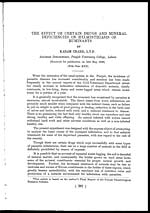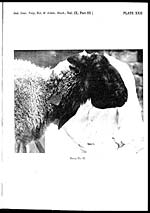Medicine - Veterinary > Veterinary colleges and laboratories > Indian journal of veterinary science and animal husbandry > Volume 9, 1939 > Original articles > Effects of certain drugs and mineral deficiencies on helminthiasis of ruminants
(168) Page 268
Download files
Individual page:
Thumbnail gallery: Grid view | List view

268 Effect of Certain Drugs etc. on Helminthiasis of Ruminants
MATERIAL AND METHOD
Experiments covered a period of three years from September 1934 to
September 1937 at the Punjab Veterinary College, Lahore. For this purpose
twenty-four calves and twenty-four sheep (all males) were selected and divided
into four groups each (six animals in each group), in such a way that the total
weight of each group of the same species was identical, and were put on a
balanced ration (concentrates, green fodder and salt) from the middle of
September. Their faeces were examined daily for helminthic egg-count up to
the middle of November each year, when the degree of infestation in each
animal was determined. From the latter period, treatment with anthelmintics
was started which continued up to the first week of January. By comparing
the egg-counts before and after the administration of anthelmintics, the
efficacy of the various drugs, tried alone or in combination, was calculated.
The four different groups were fed on special fodders from the middle of
January. Fodder for one lot (a group of calves and a group of sheep) was
procured from the water-logged region of the Deg Nullah, for a second lot from
adjacent areas but not in the water-logged region, for the third from other
areas neither water-logged, nor adjacent. Those of the fourth batch were used
as controls and kept on a balanced ration throughout the course of the
experiment.
In the beginning of June the animals were artificially infested with infec-
tive larvae of Haemonchus contortus and Oesophagostomum sp. and it was
observed that about twenty days after this infestation, the egg-count, parti-
cularly in sheep, rose to a very high level. They developed a bottle jaw
condition (Plate XXII) and razor back etc. Three calves belonging to the
different grass batches, and three sheep, two of which were kept on grasses
and the third on the balanced ration revealed degenerative changes in the eyes
leading to blindness in August. Most of the sheep and some calves succumbed
to this infestation. On autopsy a larger number of worms was found in those
receiving deficient fodders than in those fed on a balanced ration. Each
animal was weighed regularly on the same day and at the same time every
week, before its morning feed and drink. Photographs of the animals
were also taken at various stages of the experiment.
ANTHELMINTICS
In India no organised effort has so far been made to combat the helminthic
infestation in the domestic animals. In other countries, however, various
drugs have been tried and good results are claimed, but some of these drugs
being costly their use on a large scale is definitely prohibitive by reason of
expense. Thus Dungal and Gislason [1936] report that carbon tetrachloride
is very efficacious against nematode worms in sheep. Stewart and Piercy
[1934] give favourable reports regarding the efficacy of copper sulphate
(1 per cent solution) in parasitic gastroenteritis of lambs. Gordon [1935]
found that sodium arsenite gave a variable and low average when used against
Haemonchus contortus in sheep, but gave excellent results when mixed with
Set display mode to: Large image | Zoom image | Transcription
Images and transcriptions on this page, including medium image downloads, may be used under the Creative Commons Attribution 4.0 International Licence unless otherwise stated. ![]()
| Permanent URL | https://digital.nls.uk/75246940 |
|---|
| Description | Covers articles from 1939. Please note that pagination starts at p.139 and plates at Plate V. |
|---|




